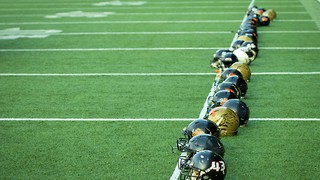Rogue Sport of the Week: Rugby Fives with Ben Beltrami
Keir Baker speaks to the captain of the Cambridge University Rugby Fives Club about a traditional English sport

Athlete Profile
- Name: Ben Beltrami
- College: Selwyn
- Degree/Faculty: History – 3rd Year
- Hometown: London
Ben Beltrami is one of the best Rugby Fives – known simply as Fives – players in the country. He has won the National Schools Singles competition and he is – at time of interview – ranked 5th nationally in singles, and 6th in doubles. During his time at Cambridge, he has won the doubles title at the 2014 and 2015 British Universities Rugby Fives Championships as well as finishing runner-up in the singles at the 2015 competition. He also finished second in both the singles and doubles competition at the National Under-25’s Tournament. He is one of only five Fives players to have been awarded a Full Blue.
Can you give us a brief summary of Fives?
The simplest way to describe it is as playing squash with your hands. You play in a court – which is effectively just a room with lines on the wall – and the aim is to hit a ball against the front wall, above a certain line. And, as long as the ball hits that front wall, you can hit the ball against the back or the side walls too. You hit the ball alternately with your opponent, and you win a point if they miss it – in the sense that the ball bounces twice – or they fail to hit the front wall above the line.
The scoring differs from squash: you can only win points when you are receiving serve. And the matches are best of three sets either to 11 or 15 points – so a long three-set match can last up to two hours, depending on the competitiveness of the match. Indeed, it can be quite frustrating: the rallies can last a while and the score can remain static if both players are particularly good at serving.
How does it differ from Eton Fives?
Eton Fives is quite similar, but the two sports differ in terms of the court used. Rugby Fives is played in a slightly smaller squash court, but Eton Fives uses a differently shaped court: it’s got only three walls (there is no back wall), lots of ledges everywhere and it even has a step. It’s based on a part of the school at Eton where it was first played. Eton Fives is only played in doubles too.
How did you first get into Fives?
I hadn’t heard of it until I went to secondary school. There, they had a system whereby everyone had to try loads of different sports during first year, and the first sport I tried was Fives. There was a teacher who was very keen on it and he promoted it a lot. I had played tennis and other racquet sports before, so I figured I might be good at it. And when I discovered I was, I basically kept at it from there.
I think it helped that I started at the best time physically – there were a few years in which I could have played beforehand, but I probably wouldn’t have been as good as I lacked the strength and speed.
Is there a certain technique that everyone follows?
There’s usually a variety of techniques on display at tournaments, but there are some that allow you to get more power than others, which are normally dependent upon how much you bend and draw back your arm. Generally, everyone’s stroke has the same basic foundation of crouching down and following through, but the actual stroke people use is unique to them.
However, the quality of the stroke can depend heavily on the hand being used. One of the hardest things about the sport is getting your weaker hand strong enough to hit decent shots. It’s a tough barrier to overcome, and requires a fair bit of practice and honing of the technique.
What traits help facilitate success in Fives?
Obviously, good hand-eye coordination is a must. Being reasonably quick is useful too, but to be honest, someone starting up would really need a willingness to try something different and to stick at it. It’s amazing how quickly you can get good at and really enjoy Fives because it is a simple game.
Who is the most famous athlete in the sport?
The best player of all time was called Wayne Enstone, who played during the 1970s and 1980s. He won the National Single Title 23 times and the National Doubles Title 15 times, as well as a vast number of regional tournaments. He’s a big deal because Fives was historically a public school sport, but he was the first non-public school player to win the National Singles Title.
Currently, the top two players are called Will Ellison and Dan Tristao. They dominate the sport, and everyone is trying to reach their level. Indeed, they have a similar relationship to the one Novak Djokovic and Roger Federer used to have: if both enter a singles tournament, they’ll get to the final. The closest players to catching up with them are probably either Dan Grant or our own Ed Kay, who’s the first seed at Cambridge.
What is the state of the sport in Cambridge and in the UK?
We recently had some new, modern courts built in the new sports centre in West Cambridge and we have about eight or nine players who play pretty regularly, so we’re in good shape. In fact, our top four is very strong – they are the reason we’ve had so much success against Oxford in Varsity matches – and all of our top three are ranked within the top 10 nationally. One of the new freshers is the guy who won the National Schools Championships too!
On a wider level, the sport is mainly just based in the UK – there are hardly any courts in any other countries. It’s a completely amateur sport – there are probably about 30 or 40 players who turn up with a degree of regularity to tournaments, of which there are about 10 or 15. Still, it’s very competitive, particularly as you get higher in the rankings.
What is your training schedule like?
I play Fives two times a week, go to the gym three or four times a week, and I also have an agility session every week too. The gym usually consists of strength training using free weights. My cardio training tends to come from playing Fives as well as lots of squash too.
How do you reconcile your training schedule with a Cambridge workload?
Normally, I aim to get a routine going: whenever I have a session, I block out the time and work around it. I find having a degree of regularity can help train the mind and help you stick to your goals.
How might somebody interested in Fives get involved?
They would get involved through the Cambridge University Rugby Fives Club, which is also known as the Sparrows. Despite the high quality of our top four, there are a lot of spaces open in our Seconds squad, which is a lot more relaxed, more competitive and more open to new members making the team. We’re particularly looking for girls to join in: last year was the first ever women’s Varsity Match, and we want to keep that up.
Our website is probably the best place to visit, but if anyone has any specific questions about Fives, they could email our secretary Matt Shaw (mattshw3@gmail.com) or myself (bmjb2@cam.ac.uk).
This interview has been edited for length and clarity
 News / Cambridge academics stand out in King’s 2026 Honours List2 January 2026
News / Cambridge academics stand out in King’s 2026 Honours List2 January 2026 Interviews / You don’t need to peak at Cambridge, says Robin Harding31 December 2025
Interviews / You don’t need to peak at Cambridge, says Robin Harding31 December 2025 News / AstraZeneca sues for £32 million over faulty construction at Cambridge Campus31 December 2025
News / AstraZeneca sues for £32 million over faulty construction at Cambridge Campus31 December 2025 News / News in Brief: Maypole mentions, makeovers, and moving exhibits4 January 2026
News / News in Brief: Maypole mentions, makeovers, and moving exhibits4 January 2026 Features / “It’s a momentary expression of rage”: reforming democracy from Cambridge4 January 2026
Features / “It’s a momentary expression of rage”: reforming democracy from Cambridge4 January 2026










